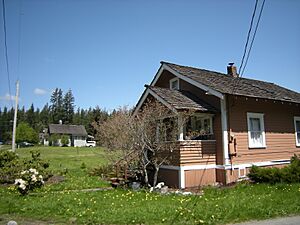Selleck, Washington facts for kids
Quick facts for kids |
|
|
Selleck Historic District
|
|

Selleck, Washington
|
|
| Lua error in Module:Location_map at line 420: attempt to index field 'wikibase' (a nil value). | |
| Nearest city | Maple Valley, Washington |
|---|---|
| Area | 18 acres (7.3 ha) |
| Architectural style | Bungalow/craftsman |
| NRHP reference No. | 89000214 |
| Added to NRHP | March 16, 1989 |
Selleck is a historic place in Washington. It was founded in 1908. Selleck was once a "company town." This means one company owned most of the town and its homes.
Selleck is special because it is the only surviving company mill town in King County. Because of its history, it is listed on the National Register of Historic Places. It is also recognized as a King County landmark.
Contents
Selleck's Early Days
Selleck was built near the mountains in southeast King County. It was the company town for Pacific States Lumber. A lumberman named Frank Selleck led its creation. A lumberman is someone who works in the timber business.
The town was finished in 1916. It had a very tall railway trestle. This bridge was 204 feet high over the Cedar River. It was once the world's highest railway trestle.
Selleck's Role in Rebuilding Tokyo
The lumber mill in Selleck played an important part in history. It helped rebuild Tokyo, Japan. This was after a huge earthquake in 1923. Many Japanese workers and their families came to Selleck to work at the mill during this time.
Japanese Community in Selleck
Japanese workers and their families lived in an area outside the main town. It was officially called Lavender Town. Children from these families went to the Selleck School. They also attended a special Japanese-language school. This school was held on Wednesday and Saturday mornings.
Traces of the Past
Today, there are not many signs left of Lavender Town. Even old grave markers, thought to be made of wood, are gone. The only clear sign of the Japanese community is a pond with bamboo plants. Because so few traces remain, Lavender Town is not part of Selleck's landmark status. Future archaeological digs might uncover more history.
Selleck's Decline and Changes
At its busiest, Selleck had about 900 people living there. It had a hospital, two hotels, and a community hall. There were weekly dances, a school, and several stores. The town also had many mill buildings.
In 1939, Pacific States Lumber went out of business. This ended Selleck's time of growth and wealth. The town was sold many times after that. One buyer even bought it for only $3,000.
New Visions for Selleck
In 1971, Robert Schaefer and a group of investors bought the town. Schaefer was a general contractor from Renton, Washington. He had big plans for Selleck. He wanted to bring back the old millpond. He imagined paddleboats and a train ride around the pond. He also hoped to create a logging theme park.
However, these plans did not fully happen. Rules about wetlands and a lack of money made it difficult. The town also faced problems with its water system in the 1990s.
Selleck Today
Today, Robert Schaefer's son, Tim Schaefer, owns the town. The old two-story schoolhouse is still there. The former community hall also remains. About half of the original company houses are still standing. People live in about 50 of these bungalow-style homes. Renting a four-bedroom house in Selleck costs about the same as a two-bedroom apartment in other parts of the county.
See also
 In Spanish: Selleck (Washington) para niños
In Spanish: Selleck (Washington) para niños


